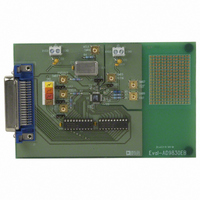EVAL-AD9830EBZ Analog Devices Inc, EVAL-AD9830EBZ Datasheet - Page 6

EVAL-AD9830EBZ
Manufacturer Part Number
EVAL-AD9830EBZ
Description
BOARD EVALUATION AD9830
Manufacturer
Analog Devices Inc
Specifications of EVAL-AD9830EBZ
Main Purpose
Timing, Direct Digital Synthesis (DDS)
Utilized Ic / Part
AD9830
Lead Free Status / RoHS Status
Lead free / RoHS Compliant
Secondary Attributes
-
Embedded
-
Primary Attributes
-
Lead Free Status / Rohs Status
Supplier Unconfirmed
AD9830
TERMINOLOGY
Integral Nonlinearity
This is the maximum deviation of any code from a straight line
passing through the endpoints of the transfer function. The
endpoints of the transfer function are zero scale, a point 0.5
LSB below the first code transition (000 . . . 00 to 000 . . . 01)
and full scale, a point 0.5 LSB above the last code transition
(111 . . . 10 to 111 . . . 11). The error is expressed in LSBs.
Differential Nonlinearity
This is the difference between the measured and the ideal 1 LSB
change between two adjacent codes in the DAC.
Signal to (Noise + Distortion)
Signal to (Noise + Distortion) is measured signal to noise at the
output of the DAC. The signal is the rms magnitude of the fun-
damental. Noise is the rms sum of all the nonfundamental sig-
nals up to half the sampling frequency (f
the dc component. Signal to (Noise + Distortion) is dependent
on the number of quantization levels used in the digitization
process; the more levels, the smaller the quantization noise.
The theoretical Signal to (Noise + Distortion) ratio for a sine
wave input is given by
where N is the number of bits. Thus, for an ideal 10-bit con-
verter, Signal to (Noise + Distortion) = 61.96 dB.
Total Harmonic Distortion
Total Harmonic Distortion (THD) is the ratio of the rms sum
of harmonics to the rms value of the fundamental. For the
AD9830, THD is defined as
where V
V
sixth harmonic.
4
, V
5
and V
Signal to (Noise + Distortion) = (6.02 N + 1.76) dB
1
is the rms amplitude of the fundamental and V
THD 20log
6
are the rms amplitudes of the second through the
(V
2
2
V
3
2
V
V
1
4
2
MCLK
V
5
2
/2) but excluding
V
6
2
2
, V
3
,
–6–
Output Compliance
The output compliance refers to the maximum voltage which
can be generated at the output of the DAC to meet the specifi-
cations. When voltages greater than that specified for the out-
put compliance are generated, the AD9830 may not meet the
specifications listed in the data sheet. For the AD9830, the
maximum voltage which can be generated by the DAC is 1V.
Spurious Free Dynamic Range
Along with the frequency of interest, harmonics of the funda-
mental frequency and images of the MCLK frequency will be
present at the output of a DDS device. The spurious free dy-
namic range (SFDR) refers to the largest spur or harmonic
which is present in the band of interest. The wideband SFDR
gives the magnitude of the largest harmonic or spur relative to
the magnitude of the fundamental frequency in the bandwidth
SFDR gives the attenuation of the largest spur or harmonic in a
bandwidth of 200 kHz and 50 kHz about the fundamental
frequency.
Clock Feedthrough
There will be feedthrough from the MCLK input to the analog
output. The clock feedthrough refers to the magnitude of the
MCLK signal relative to the fundamental frequency in the
AD9830’s output spectrum.
2 MHz about the fundamental frequency. The narrowband
REV. A




















